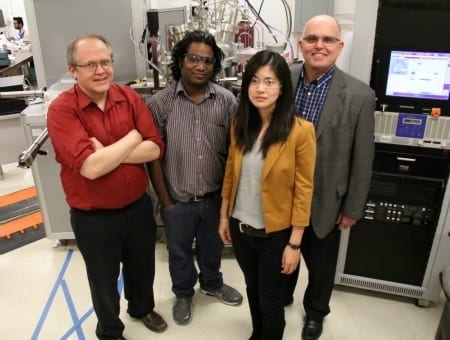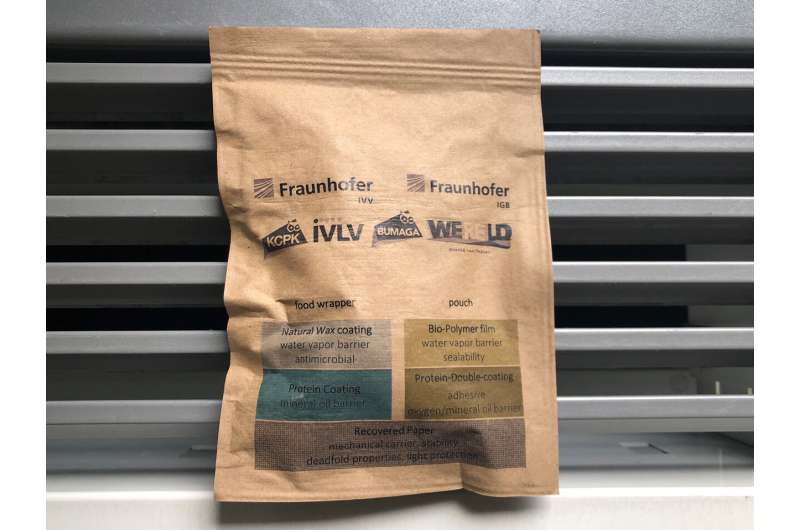
Bingyuan Ma holding a transparent capillary cell. Bai’s Lab at the McKelvey School of Engineering is the only one in the world with such diagnostic cells.
(Courtesy: Bai Lab)
One-of-a-kind tool helped solve anode puzzle that thwarted previous attempts
When it comes to batteries, lithium-ion are the best we have as far as energy density and convenience.
For now.
The Washington University in St. Louis lab of Peng Bai, assistant professor in the Department of Energy, Environmental & Chemical Engineering in the McKelvey School of Engineering, has developed a stable sodium ion battery that is highly efficient, will be less expensive to make and is significantly smaller than a traditional lithium ion battery due to the elimination of a once-necessary feature.
“We’ve found that the minimal is maximum,” Bai said. “No anode is the best anode.”
The research was published May 3, 2021, in the journal Advanced Science.
A traditional lithium ion battery consists of a cathode and anode, both of which store lithium ions; a separator to keep the electrodes separated on either side; and an electrolyte — the liquid through which the ions move. When lithium flows from the anode to the cathode, free electrons leave through the current collector to the device being powered while the lithium passes the separator to the cathode.
To charge, the process is reversed, and the lithium passes from the cathode, through the separator, to the anode.
The concept of replacing lithium with sodium and doing away with the anode isn’t new.
“We used old chemistry,” Bai said. “But the problem has been, with this well-known chemistry, no one ever showed this anode-free battery can have a reasonable lifetime. They always fail very quickly or have a very low capacity or require special processing of the current collector.”
Anode-free batteries tend to be unstable, growing dendrites — finger-like growths that can cause a battery to short or simply to degrade quickly. This conventionally has been attributed to the reactivity of the alkali metals involved, in this case, sodium.
In this newly designed battery, only a thin layer of copper foil was used on the anode side as the current collector, i.e., the battery has no active anode material. Instead of flowing to an anode where they sit until time to move back to the cathode, in the anode-free battery the ions are transformed into a metal. First, they plate themselves onto copper foil, then they dissolve away when it’s time to return to the cathode.
“In our discovery, there are no dendrites, no finger-like structures,” said Bingyuan Ma, the paper’s first author and a doctoral student in Bai’s lab. The deposit is smooth, with a metal luster. “This kind of growth mode has never been observed for this kind of alkali metal.”
“Observing” is key. Bai has developed a unique, transparent capillary cell that offers a new way to look at batteries. Traditionally, when a battery fails, in order to determine what went wrong, a researcher can open it up and take a look. But that after-the-fact kind of observation has limited usefulness.
“All of the battery’s instabilities accumulate during the working process,” Bai said. ”What really matters is instability during the dynamic process, and there’s no method to characterize that.” Watching Ma’s anode-free capillary cell, “We could clearly see that if you don’t have good quality control of your electrolyte, you’ll see various instabilities,” including the formation of dendrites, Bai said.
Essentially, it comes down to how much water is in the electrolyte.
Alkali metals react with water, so the research team brought the water content down. “We were hoping just to see a good performance,” Bai said. Watching the battery in action, the researchers shortly saw shiny, smooth deposits of sodium. It’s the smoothness of the material that eliminates morphological irregularities that can lead to the growth of dendrites.
Original Article: Bai lab develops stable, efficient, anode-free sodium battery
More from: Washington University in St. Louis
The Latest Updates from Bing News & Google News
Go deeper with Bing News on:
Anode-free sodium battery
- ‘Battery revolution’? First US sodium-ion plant comes online.
The first sodium-ion battery plant in the U.S. started operations Monday, offering an alternative to lithium-based storage that currently dominates the market.
- Breakthrough in Sodium Battery Chemistry Promises Lower Costs
A new mass synthesis process for sodium-containing sulfides could make all-solid-state sodium batteries more affordable and safer than lithium-ion batteries.
- Scientists make breakthrough in production of salt-based battery technology: 'This process makes it easier'
The breakthrough could be a great win for the EV market. Scientists make breakthrough in production of salt-based battery technology: 'This process makes it easier' first appeared on The Cool Down.
- Novel Anode Material Boosts Lithium-Ion Battery Performance
Dr. Han Joong Tark and student researcher Lee Do Geun at Korea Electrotechnology Research Institute's Nano Hybrid Technology Research Center have devised a novel manufacturing method for ...
- Sodium-ion battery could charge in several seconds
Researchers at the Korea Advanced Institute of Science and Technology (KAIST) have identified a high-energy, high-power hybrid sodium-ion battery capable of charging in just a few seconds. The system ...
Go deeper with Google Headlines on:
Anode-free sodium battery
[google_news title=”” keyword=”anode-free sodium battery” num_posts=”5″ blurb_length=”0″ show_thumb=”left”]
Go deeper with Bing News on:
Sodium ion battery
- Lithium Faces Challenge From Sodium Batteries
Lithium-ion has been the dominant rechargeable battery technology for years, but the strong charge and discharge capacities from Sodium batteries could make a difference in the energy storage business ...
- New sodium-ion battery tech boosts green energy storage affordability
In an advance for energy-storage technologies, researchers have developed high ionic-conductivity solid-state electrolytes for sodium-ion batteries that dramatically enhance performance at room ...
- ‘Battery revolution’? First US sodium-ion plant comes online.
The first sodium-ion battery plant in the U.S. started operations Monday, offering an alternative to lithium-based storage that currently dominates the market.
- Scientists design super-battery made with cheap, readily affordable chemical element, Na — Salt-based cell has surprisingly good energy density and charges in seconds
R esearchers at the Korea Advanced Institute of Science and Technology (KAIST) have developed a high-performance, hybrid sodium-ion battery that charges rapidly and offers impressive energy density.
- Sodium-ion batteries from Michigan plant to challenge lithium’s grip
Natron Energy Inc. bills the facility near the Lake Michigan shore as the first full-scale U.S. plant for making sodium-ion batteries.
Go deeper with Google Headlines on:
Sodium ion battery
[google_news title=”” keyword=”sodium ion battery” num_posts=”5″ blurb_length=”0″ show_thumb=”left”]










